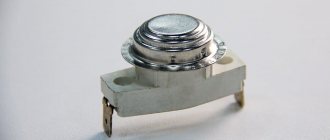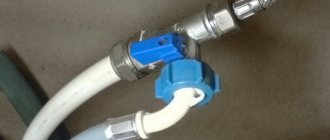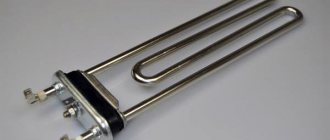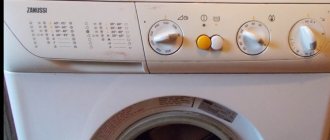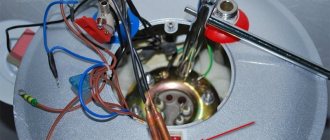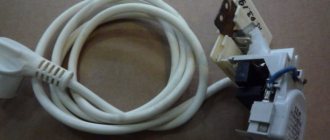The washing machine does not heat the water when washing. This problem occurs quite often, and there are many reasons why the water does not heat up. It is very important to eliminate this problem, because washing different types of laundry requires a certain temperature.
Every housewife knows that in order to achieve the best washing result, you should select the desired temperature mode. For this purpose, there is a special tag on things, which indicates a point or digital value of the recommended temperature. If woolen items are washed in cold water, then bed linen or towels are washed in water heated to a certain temperature. But what to do if the washing machine does not heat the water? This article will describe and analyze the main causes of this malfunction, as well as ways to solve them.
How to check if a washing machine is heating water
A situation may occur when the washing unit has fully completed all stages of washing, but the laundry was poorly washed, although the same detergent was used. One of the reasons may be non-compliance with the temperature regime. In other words, the machine washed clothes in cold water. In this case, it is worth checking whether the water entering the washing drum is heating up.
To do this, you need to select one of the washing modes, which involves heating the water to a temperature of 50-60*C and 20 - 30 minutes after it starts, touch the glass of the loading hatch. For top-loading machines, place your palm on the top cover. If these elements are warm, the water heats up; if they are cold, the washing unit is faulty. After finishing washing, you should identify the causes of the malfunction and eliminate the malfunction. Further use of the washing machine will not only not lead to the desired washing result, but may also render it completely unusable.
Reasons why the washing machine does not heat the water
A washing unit is a complex household device consisting of many elements. The reason for the lack of water heating may be a malfunction or breakdown of:
- heating element (heating element);
- water heating sensor (thermostat);
- programmer (electronic unit);
- water level sensor in the tank (pressostat).
Also, the water may not heat up enough when:
- incorrect connection of the washing unit to the drainage system, resulting in self-draining of heated water caused by the siphon effect;
- incorrect choice of washing program, in which the selected mode in favor of a higher temperature mode is ignored.
There are many reasons why the machine does not heat the water, so in order to find out the source of the malfunction, you need to follow the principle “from simple to complex.”
The washing machine does not heat the water: reasons
The specificity of the breakdown is that it is difficult to establish immediately. Things remain cold after being removed from the tank due to rinsing in cool water. You can check the presence of heating 15 minutes after the start of the program. Just touch the glass on the hatch. If it does not start to warm up, there is a failure.
If the washing machine does not heat the water, the quality of the wash will noticeably deteriorate.
Why does the water not fully heat up or remain cold at all in a household washing machine? There are several reasons for this.
Incorrect connection
Water is constantly being filled and drained into the equipment without having time to warm up. If installed incorrectly, it is easy to confuse the outlets of the drain and supply hoses. The pipes must be disconnected and reconnected according to the manufacturer's instructions.
Incorrect mode selection
When an automatic washing machine does not heat cold water in certain programs, you need to check the mode selection. Modern SMAs come pre-installed with several temperature functions. You can read about the presence of heating in the instructions.
Important! For tulle, lace, natural silk and wool, only washing at 30 degrees is suitable.
Level sensor faulty
The pressure switch determines the amount of water in the drum, as well as the liquid pressure.
Control is carried out by a pipe fixed to the membrane.
If clogged with threads, wool and small debris, the heating command is not given.
Problems with the heating element
During operation, the tubular heater becomes covered with plaque and rust. The water does not heat due to mechanical damage to the part or rupture of the wires going to it.
Scale or increased water hardness
Hard water leads to the formation of deposits on the working units of the SMA due to constant exposure to a humid environment. The presence of soap deposits and scale provoke an unpleasant odor and lack of heating of the water. For prevention, buy special softeners or powders with similar additives.
Important! The average water hardness in Russia is 7 mg-eq/l compared to 1-2 mg-eq/l in Europe. Softeners must be used.
Heating sensor failure
The thermostat is responsible for heating the water during the program. He turns the heating element on and off.
If the heating sensor breaks down, the water does not become warm or heats up too much.
To detect a malfunction, you need to check the thermostat and replace it if necessary.
Breakdown of the software center
Failures of the software module appear when the machine is correctly connected to communications and the desired mode is selected. If the washing machine still does not heat cold water, and you don’t know what to do, you should immediately test the programmer. It fails due to a voltage drop in the network. Reset all settings or reflash the control board.
Identifying the faulty element
If periodic self-draining of warm or hot water occurs (can be monitored by heating the drain hose), it is necessary to eliminate the siphon effect and correctly connect the washing unit to the drain system. The problem is successfully solved by installing a check valve in the system.
If the washing machine does not heat the water at all, you should remove the back or side covers and check the connection of the heating element terminals (TENA) with the current-carrying wires.
When washing, especially in spin modes, all elements of the washing unit are subject to vibration loads, which can lead to separation of the elements. By reconnecting the disconnected wire, you can eliminate the problem.
Washing units from Samsung, LG, Ariston, Candy, Bosch and other well-known brands have a similar structure and connection of heating elements. As a rule, a tubular heating element is used, which converts electrical energy into thermal energy by creating electrical resistance.
Diagnostics of heating element
Failure of the heating element is the most common reason that the water in the washing machine does not heat up. Under normal conditions, the heating element is designed for a long period of operation, 5 - five or more years. However, hard water, low-quality detergents or failure to comply with the operating conditions of the washing unit lead to the formation of scale on the heating element. As a result of this, the heat transfer process is disrupted, the heating element overheats and burns out.
Electric heating elements are used in many household appliances: kettles, pressure cookers, boilers, etc. They can be dry or wet type. Dry heating elements do not come into direct contact with water or other liquid. Washing units from most manufacturers use wet heating elements. Korean washing machines Samsung and LG, Italian Ariston or German Bosch are all equipped with similar heating elements. They may vary in appearance and power.
Household washing units use heating elements with a power of 1.5 to 2.5 kW. The power is usually indicated on the device case, or in the accompanying technical documentation. In order to make sure that the heating element is working, you need a multimeter (tester). To ensure an accurate check, it is better to calculate the resistance for a specific element using the formula:
R=U²/P where:
R – resistance in Ohm;
U – network voltage in V;
P – heating element power W.
For example, let's take a heating element with a power of 2000W (or 2 kW).
R= 220²/2000= 24.2 Ohm
The calculated resistance for a 2 kW heating element was 24.2 Ohms.
To check you need:
- disconnect the wires from the heating element connectors;
- switch the multimeter to resistance measurement mode with a measurement range of no more than 1000 Ohms;
- Touch the probes of the multimeter to the outer terminals (contacts) of the heating element.
If the heating element is working properly, the device readings should be close to the calculated value. “Zero” indicates a short circuit inside the heating element and it needs to be replaced. If the device readings show “one” or the “infinity” symbol, the heating element has a break, and it also requires replacement.
To check the breakdown on the body, the tester switch is set to the “buzzer” mode and one of the probes of the device is connected to one of the contacts of the tank, the other to the body of the heating element. If there is no breakdown in the housing, the multimeter's buzzer will not sound. Otherwise, if the device beeps or displays numbers, then there is a breakdown in the housing, and the heating element requires replacement.
Heating element test
First, disconnect the washing machine from the power supply and turn off the water tap. Next, we provide free access to the heater and, if necessary, remove the back wall or bottom. Next, take a multimeter and start testing.
- We photograph the heating element to record the connected wiring and eliminate errors during future installation.
- Disconnect all connected wires.
- We set up the multimeter to measure resistance and set the selector to 200 Ohms.
- We attach the probes to the contacts.
- Let's evaluate the result.
A working heater always shows a fixed value of 26.8 ohms. Slight deviations from the norm within +-5 are possible. If one is displayed on the screen, then a line break has occurred inside the heating element and a part change is necessary. When the tester showed “0” or another number less than 1, a short circuit was detected and the element burned out.
Voltage drops in the electrical network and hard water with an abundance of impurities lead to problems with the heater.
Often, checking for resistance is not enough, since if the external condition is good, the dielectric inside can leak into the housing and cause a current leak. To ensure safe operation of the machine, it is recommended to check the heating element for breakdown. It is enough to turn the tester into buzzer mode, attach one probe to the contact, and attach the second to the body of the multimeter. If there is no piercing squeak, everything is fine. Otherwise, it is necessary to urgently change the part and not use the machine until the repair is completed.
Interesting:
- How to turn off the timer on a washing machine?
- Electrolux washing machine does not heat water
- Samsung washing machine does not heat water
- The drum does not spin in a Siemens washing machine
- How to find out that the heating element in the washing machine has burned out and how to fix it?
- The drum in the washing machine does not spin well
Reader comments
- Share your opinion - leave a comment
Temperature sensor diagnostics
If the heating element is working properly, but the water in the washing machine does not heat up, we check the water heating sensor in the washing tank.
As a rule, it is located on the body of the heating element and is a small metal cylinder with connected electrical wires, however, on some units, for example Bosch, its appearance may be different. To do this you will need:
- disconnect the sensor wires and carefully remove it from the tank;
- use a multimeter to measure its resistance and remember the readings of the device;
- place the sensor in hot water and measure the resistance again; if the difference in readings is significant, the sensor is working; if not, it needs to be replaced.
Pressostat test
The pressure switch is easier to understand. We unscrew the two screws holding the cover from the back of the case, move it forward, remove it and look for the level sensor. It is located on the right side and looks like a black and white plastic “puck” with a long hose lowered into the tank. Next we proceed like this.
- We find a tube with a diameter equal to the sensor fitting.
- Disconnect the hose by releasing the clamp.
- Insert the tube into the hose and blow lightly.
- We listen: if you hear 1-3 clicks, then the contacts of the device work perfectly.
The verification does not end there. The second step is to inspect all components of the pressure switch for damage, chips, traces of burning and cracks. Next, check to see if the hose is clogged and, if necessary, rinse it under the tap. In the third step, it is recommended to use a multimeter, following the following instructions.
- We find the electrical circuit of the unit and find out which contacts to connect to for diagnostics.
- Select the “Resistance” mode on the tester.
- We connect the probes to the contacts of the pressure switch.
- We evaluate the indicators on the display: if the values change, then it’s ok. Otherwise, it will have to be replaced.
Repairing a pressure switch is difficult and pointless - it’s easier and cheaper to buy a new one. The process of dismantling the old sensor is simple: loosen the clamps, remove the chip with the wiring and disconnect the “washer”. A working device is installed in the reverse order. If the heating element and pressure switch pass the test, then the problem is with the control board. There is no need to experiment here - we immediately turn to professionals for high-quality diagnostics.
Interesting:
- Atlant washing machine does not heat water
- Why does my Ariston washing machine not heat the water when washing?
- Repairing malfunctions of the Indesit washing machine...
- Electrolux washing machine does not heat water
- The washing machine does not spin well - what should I do?
- Indesit washing machine takes a long time to wash
Reader comments
- Share your opinion - leave a comment
Checking the pressure switch
If the heating element and temperature sensor are working properly, and the washing machine does not heat the water, you need to check the water level sensor in the tank (pressostat).
If the pressure switch tube is clogged with lint and small debris, it may result in the sensor not sending a signal that the washing tank is full of water. As a result, the control module does not turn on the heating element, or does not give a signal to open the intake valve. As a result, the water does not heat up in the washing machine. You can determine the blockage visually by removing the top or side cover of the washing unit and removing the tube.
Diagnosis of Indesit washing machine malfunctions and solutions to the problem
You should start searching for what exactly influenced the lack of heating from the simplest options, gradually moving on to nodes that are difficult to analyze.
Does it really not heat up?
First you need to make sure that the water does not really heat up during washing . The fact that the washed clothes are cold does not mean anything.
After processing in the machine, it is also rinsed and wrung out, and remains in the washing machine for some time after the wash is finished.
You can check the timing of heating during the washing process. To do this, just wait until intense heating begins according to the program, and carefully touch the sunroof glass with your hand .
The heating process can be noticed by the more intense rotation of the counter during operation of the washing machine.
Operating mode and selection of settings
You should also check which program mode is selected and what the heating temperature is. Many modes (for example, washing wool) involve processing at a low temperature of 30ºC. This may give the impression that there is no heating, but this is not the case. If you need to wash at high temperatures, you must select the appropriate mode.
Failure of the heating element
If the heating element breaks down, it needs to be replaced . It is possible to access the heating element from the rear wall through the service hatch. Before opening the washing machine, you must first turn off the power and turn off the water supply tap.
The heating element is located in the lower part, under the drum. To remove it, you must first disconnect the contacts. The condition of the heating element is checked by visual inspection and using a multimeter.
Most often, the breakdown is caused by the poor quality of tap water entering the tank. At the same time, lime begins to form on the tubular heating element, and over time the item becomes unusable. The heating element can also be damaged by foreign objects falling into the drum and the use of unsuitable detergents.
The solution to the problem is to replace the heating element with a new, similar one . After installation, you need to connect the wires.
Why the washing machine does not heat the water when washing, the video will tell you:
Problems with the thermostat
If the temperature sensor fails, the washing machine “does not understand” that the temperature has not reached the required value. If a part breaks, it is replaced with a new one.
Electrics
In rare cases, the source of the problem is broken wires or broken contacts. In this case, a breakdown can occur in any area of the involved nodes. If an obvious break is not visible, then the help of a specialist will be required to clarify the condition of the wiring.
The control module has failed
The control module can fail for various reasons. This includes moisture getting on the board, voltage surges, and mechanical damage.
In case of such a breakdown, the heating element is not sent a signal to heat the water. The failure is eliminated by repair, and if this is not possible, by replacing the unit .
Read about repairing the control module of an Indesit washing machine in this article.
The pressure switch is broken
If the pressure switch malfunctions, water heating may not occur due to the fact that the control module does not receive information about the water level in the tank . Because of this, the signal to the heating element is not sent to carry out heating.
This article will tell you about repairing the pressure switch of an Indesit washing machine.
Checking the electronic module
Malfunctions in the operation of the programmer or control unit can be caused by both software failures and failure of the electrical part.
A voltage drop can lead to burnout of electrical components. Vibration loads cause mechanical damage to electrical circuit boards. All these reasons lead to programmer failures, and the signal to turn on the heating element is not given. At home, it will be difficult to identify the cause of the malfunction, and it is better to entrust the elimination of defects in the control unit to the service center technicians.
Attention! When carrying out all work on diagnosing and repairing the internal elements of the washing unit, it is necessary to disconnect it from the electrical circuit.
Trouble-shooting
If the heating element or temperature sensor fails, they are replaced with new ones. In order to correctly select a new element in a store or market, it is best to dismantle the old one and take it with you. The seller will select the necessary analogue. If the pressure switch tube is clogged, you must remove it from the sensor fitting and try to blow it out. If the tube is severely clogged, it is necessary to remove it completely and clean it using available means, such as soft wire.
To prevent scale from forming on the heating element, temperature sensor and other elements, it is recommended to use special products when washing, such as citric acid. Periodic measures aimed at descaling using special means extend the life of the elements responsible for heating the water in the washing machine.
